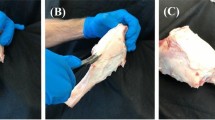Abstract
The purpose of this study is to evaluate the mechanical properties of a graft fixation using a small diameter soft tissue interference screw and analyze the factors affecting the fixation strength. Forty porcine knees were used. A bone tunnel, either 4.5 mm (n=40) or 5.0 mm (n=40) in diameter, was created in the bone block obtained from the proximal tibia or the distal femur. A patella–patellar tendon specimen with varied width was harvested, and the distal end of the patellar tendon was fixed within the bone tunnel using a small diameter soft tissue interference screw (4×15 mm). Then, the patella–patellar tendon-bone block complex was loaded until failure occurred and the maximum load was measured. As potential influential factors on the fixation strength, the insertion torque, bone mineral density of the bone block, and graft/tunnel cross-sectional area ratio (GTR) of each specimen were calculated. A significant correlation between the maximum failure load and the insertion torque was demonstrated. The quadratic regression analysis showed a statistically significant correlation between the failure load and the GTR. Optimal GTR for achieving high fixation strength was approximately 80%. When used in appropriate conditions, the mean failure load was 177 N for the 4.5 mm screw and 180 N for the 5 mm screw. The use of a small diameter interference screw for the fixation of a tendon graft to a bone is clinically feasible. Our research showed that the selection of appropriate fitting conditions is an important factor for optimizing the properties of the fixation.


Similar content being viewed by others
References
Aglietti P, Buzzi R, Zaccherotti G, et al (1994) Patellar tendon versus doubled semitendinosus and gracilis tendons for anterior cruciate ligament reconstruction. Am J Sports Med 22:211–218
Ahmad CS, Lee TQ, Elattrache NS (2003) Biomechanical evaluation of a new ulnar collateral ligament reconstruction technique with interference screw fixation. Am J Sports Med 31:332–337
Aune AK, Ekeland A, Cawley PW (1998) Interference screw fixation of hamstring vs patellar tendon grafts for anterior cruciate ligament reconstruction. Knee Surg Sports Traumatol Arthrosc 6:99–102
Brand JC Jr, Pienkowski D, Steenlage E, et al (2000) Interference screw fixation strength of a quadrupled hamstring tendon graft is directly related to bone mineral density and insertion torque. Am J Sports Med 28:705–710
Brand J Jr, Weiler A, Caborn DNM, et al (2000) Graft fixation in cruciate ligament reconstruction. Am J Sports Med 28:761–774
Corry IS, Webb JM, Clingeleffer AJ, et al (1999) Arthroscopic reconstruction of the anterior cruciate ligament: a comparison of patellar tendon autograft and four-strand hamstring tendon autograft. Am J Sports Med 27:444–454
Eriksson K, Anderberg P, Hamberg P, et al (2001) A comparison of quadruple semitendinosus and patellar tendon grafts in reconstruction of the anterior cruciate ligament. J Bone Joint Surg 83B:348–354
Fu FH, Bennett CH, Ma CB, et al (2000) Current trends in anterior cruciate ligament reconstruction: Part II. Operative procedures and clinical correlations. Am J Sports Med 28:124–130
Ishibashi Y, Rudy TW, Livesay GA, et al (1997) The effect of anterior cruciate ligament graft fixation site at the tibia on knee stability: Evaluation using a robotic testing system. Arthroscopy 13:177–182
Magen HE, Howell SM, Hull ML (1999) Structural properties of six tibial fixation methods for anterior cruciate ligament soft tissue grafts. Am J Sports Med 27:35–43
Nagarkatti DG, McKeon BP, Donahue BS, et al (2001) Mechanical evaluation of a soft tissue interference screw in free tendon anterior cruciate ligament graft fixation. Am J Sports Med 29:67–71
Noyes FR, Butler DL, Grood ES, et al (1984) Biomechanical analysis of human ligament grafts used in knee-ligament repairs and reconstructions. J Bone Joint Surg 66A:344–352
Numazaki H, Tohyama H, Nakano H, et al (2002) The effect of initial graft tension in anterior cruciate ligament reconstruction on the mechanical behaviors of the femur–graft–tibia complex during cyclic loading. Am J Sports Med 30:800–805
O’Neill DB (1996) Arthroscopically assisted reconstruction of the anterior cruciate ligament: a prospective randomized analysis of three techniques. J Bone Joint Surg 78A:803–813
Otelo AL, Hutcheson L (1993) A comparison of the double semitendinosus/gracilis and central third of the patellar tendon autografts in arthroscopic anterior cruciate ligament reconstruction. Arthroscopy 9:143–148
Rupp S, Georg T, Gauss C, et al (2002) Fatigue testing of suture anchors. Am J Sports Med 30:239–247
Selby JB, Johnson DL, Hester P, et al (2001) Effect of screw length on bioabsorbable interference screw fixation in a tibial bone tunnel. Am J Sports Med 29:614–619
Steenlage E, Brand JC Jr, Johnson DL, et al (2002) Correlation of bone tunnel diameter with quadrupled hamstring graft fixation strength using a biodegradable interference screw. Arthroscopy 18:901–907
Tsuda E, Fukuda Y, Loh JC, et al (2002) The effect of soft-tissue graft fixation in anterior cruciate ligament reconstruction on graft–tunnel motion under anterior tibial loading. Arthroscopy 18:960–967
Weiler A, Hoffmann RF, Siepe CJ, et al (2000) The influence of screw geometry on hamstring tendon interference fit fixation. Am J Sports Med 28:356–359
Acknowledgements
The authors wish to thank Mitek Japan for supplying us screws used in this investigation. Further, we thank Mrs. Janina Tubby for assistance in preparing this manuscript.
Author information
Authors and Affiliations
Corresponding author
Rights and permissions
About this article
Cite this article
Matsumoto, A., Yoshiya, S., Muratsu, H. et al. Mechanical evaluation of a soft tissue interference screw with a small diameter: significance of graft/bone tunnel cross-sectional area ratio. Knee Surg Sports Traumatol Arthrosc 14, 330–334 (2006). https://doi.org/10.1007/s00167-005-0675-0
Received:
Accepted:
Published:
Issue Date:
DOI: https://doi.org/10.1007/s00167-005-0675-0




